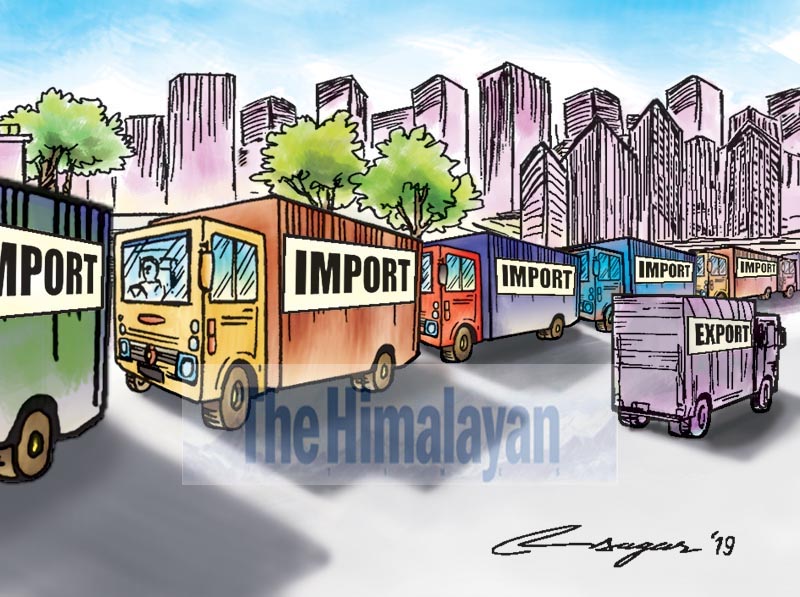Nepal’s trade gap: Serious adjustment needed
Prudence requires that further increases in foreign borrowing, especially the recourse to loans of shorter maturity and on harder terms, be restrained severely and steps be taken to accelerate the utilisation of aid
The need for bolstering our exports of traditional as well as non-traditional items to the existing and new markets to balance our trade cannot be over emphasised. The revised Nepal Trade Integration Study (NTIS), 2016 covers products like large cardamom, ginger, tea, herbs, fabrics, textiles, yarn, rope, leather, footwear, pashmina and knotted carpets; and skilled and semi-skilled professionals, IT services and business process outsourcing, and tourism. However, majority of these products have not been performing well.
Nepal is obviously dependent on imports for its developmental, construction materials and consumer items. Nepal is facing a huge trade gap to the tune of Rs 991.78 billion at the end of the third quarter in this fiscal year. While remittance inflow improved in the first eight months of the current fiscal, the ballooning trade deficit of the country remains a cause for concern.
As such, production, infrastructure and marketing are the cardinal requirements for strengthening the supply side of exportable products from Nepal. In order to increase production, the government should bring about a strict product development programme from production to export marketing level in each of the provinces.
The basic problems facing us are: Why such a sluggish growth in exports in the recent past? Has the government been able to provide proper motivation for achieving the export targets, if any? Are the new policies capable of boosting exports? What are the measures the government should take to improve exports? Is NTIS, 2017 sufficient? Who is monitoring what? Does the work of the Trade and Export Promotion Centre (TEPC) effective and efficient, and does it have the resources in terms of manpower and budget?
Nepali exportables like tea, both orthodox and CTC, large cardamom, coffee, floriculture products, non-timber forest products (NTFP), handmade paper have been identified as having comparatively high potential, but there is no promotional package to boost their exports. Though critics have attributed several external factors, such as the downward trend of world trade, increased competition and formation of regional blocks, for the slow growth of exports, the real enemy is within us. Flip-flop policies coupled with infrastructural inadequacies and bureaucratic hassles are the main stumbling blocks for growth. The negative and lethargic attitude of the Nepali diplomatic missions abroad is also an obstacle to promoting exports.
Sharp deterioration in net invisible earnings, reduction in concessional borrowing and some upsurge in bulk imports have contributed to this process. As such, increase in imports related to production of non-essential consumption goods has added to the pressure on imports. Prudence requires that further increases in foreign borrowing, especially the recourse to loans of shorter maturity and on harder terms, be restrained severely and steps be taken to accelerate the utilisation of aid. The thrust of liberalisation should also shift towards improving the technology and efficiency of the intermediate and capital goods industries, which is desirable for reducing the cost of domestic manufacture, increasing the competitiveness of the domestic industry on a wider range than at present, and building the base for greater self-reliance.
As Nepal has already entered into the Multilateral and Regional Trading Arrangements (RTAs) like the WTO, BIMSTEC, SAFTA and BBIN, the recommended strategy for rapid export growth is that more attention be focussed on expanding exports of labour-intensive manufactures.
At the same time, there must be diversification into a wider range of products, such as IT and IT-enabled services like software and other semi-manufactured, manufactured and skill-based services products; strengthening of institutional infrastructure for exports, such as the TEPC; modernisation of other trade promotional institutions and elimination of procedural bottlenecks; trade facilitation, lowering and eliminating export duties and taxes; rationalisation of incentives, speedy delivery of raw materials, equipment and components related to export production; and adequate investment provision for infrastructure where there is a high concentration of export production industries.
In the case of Nepal, we cannot imagine success in the export trade until and unless we commercialise the agriculture sector. It is, therefore, Nepal’s reality, compulsion, hope, demand and precondition to make sincere efforts in its development.
Service sector trading is also gaining momentum these days. Tourism has demonstrated its potential in contributing substantially to foreign exchange earnings. The circumstances are propitious for a rapid expansion of tourism. The tourism industry does not encounter protectionist barriers. The future expansion of tourism should be achieved mainly through the private sector. The state can contribute by planning broad strategies of development, providing essential infrastructure, and devising effective regulatory mechanisms to protect the interest of the industry, the consumer and environment. In sum, Nepal’s ever increasing trade gap in the recent years deserves due consideration from all the stakeholders. In this, the Public Private Partnership approach is required.
Singh is former CEO of NEPSE and former Executive Director of SEZ






